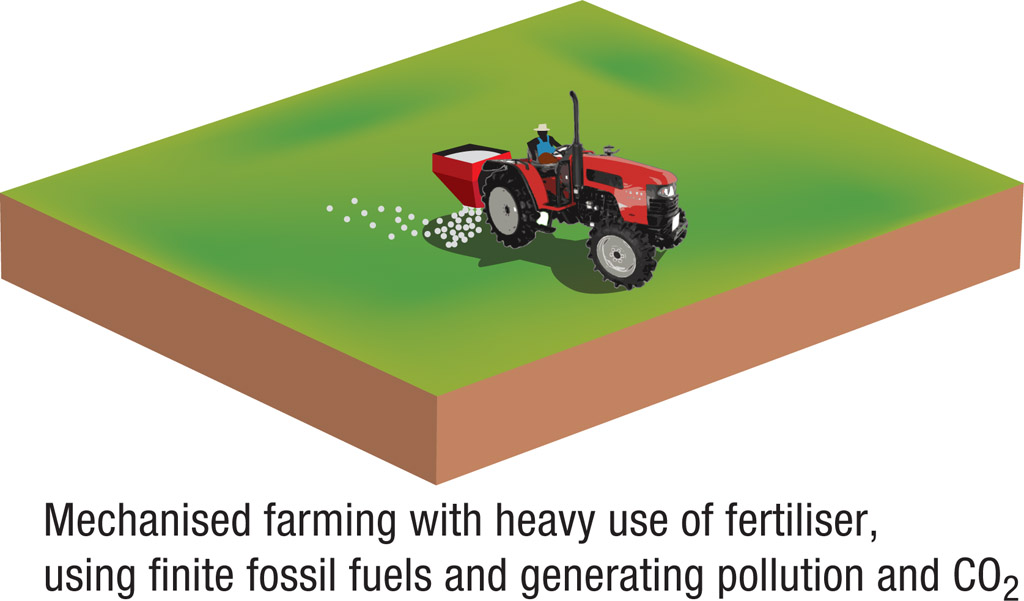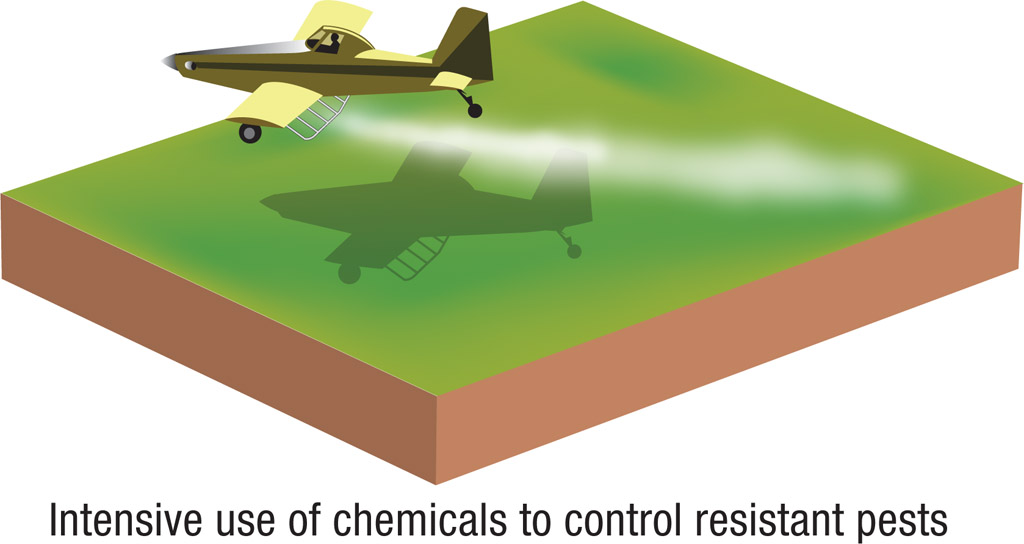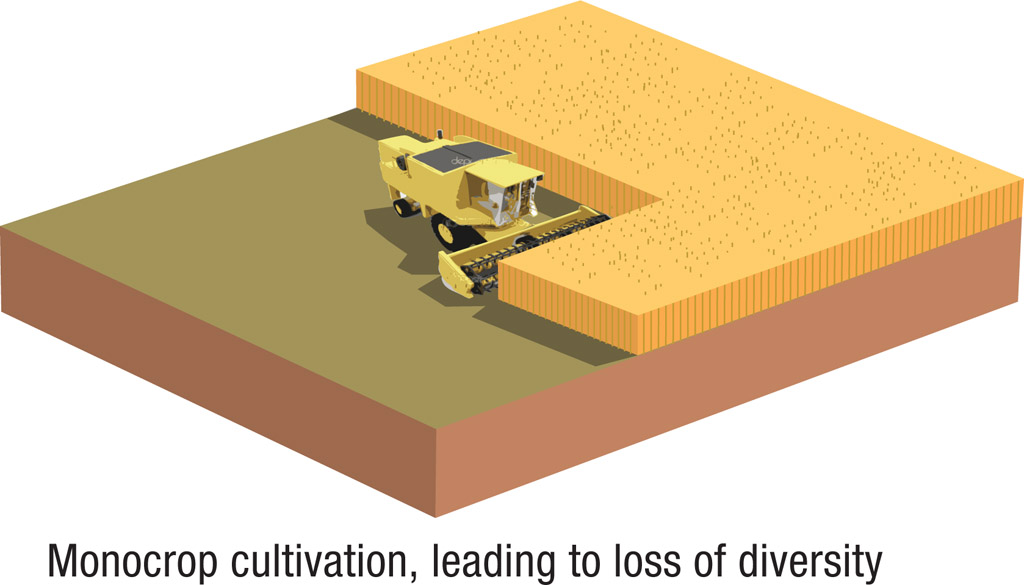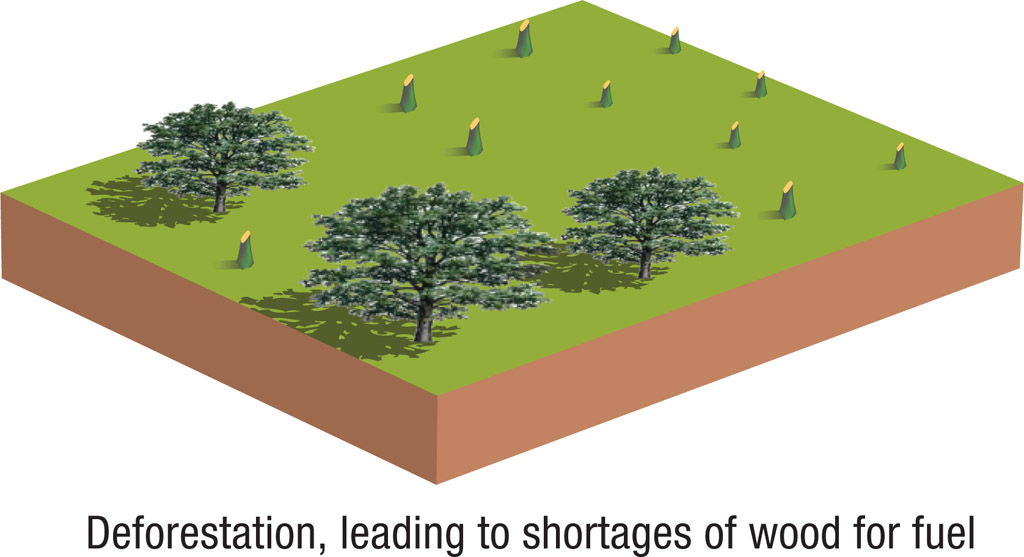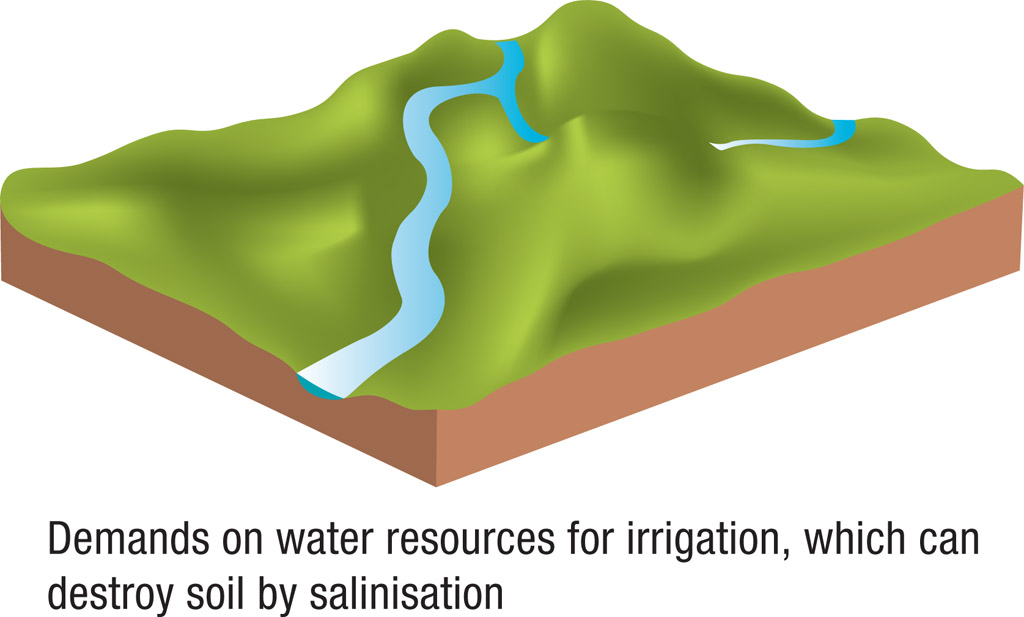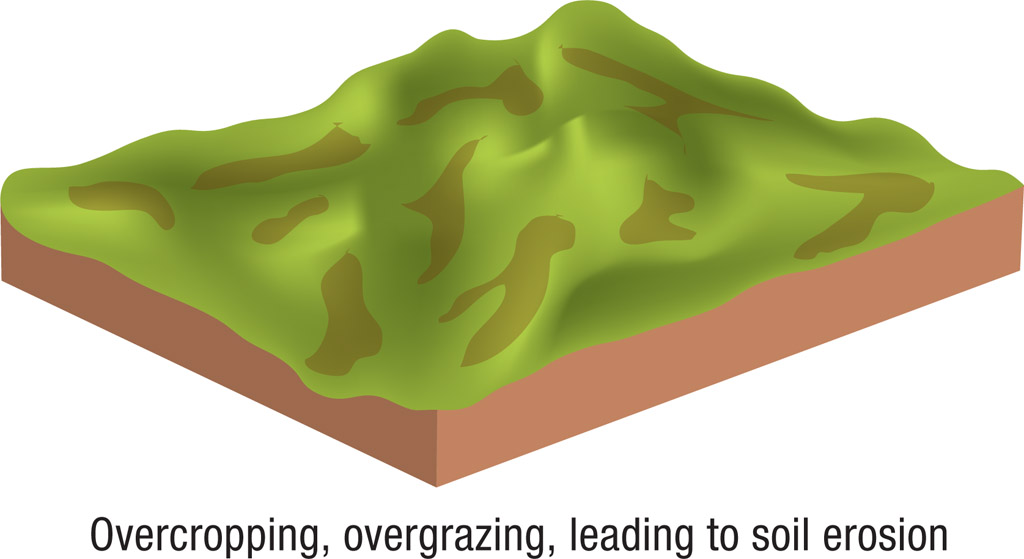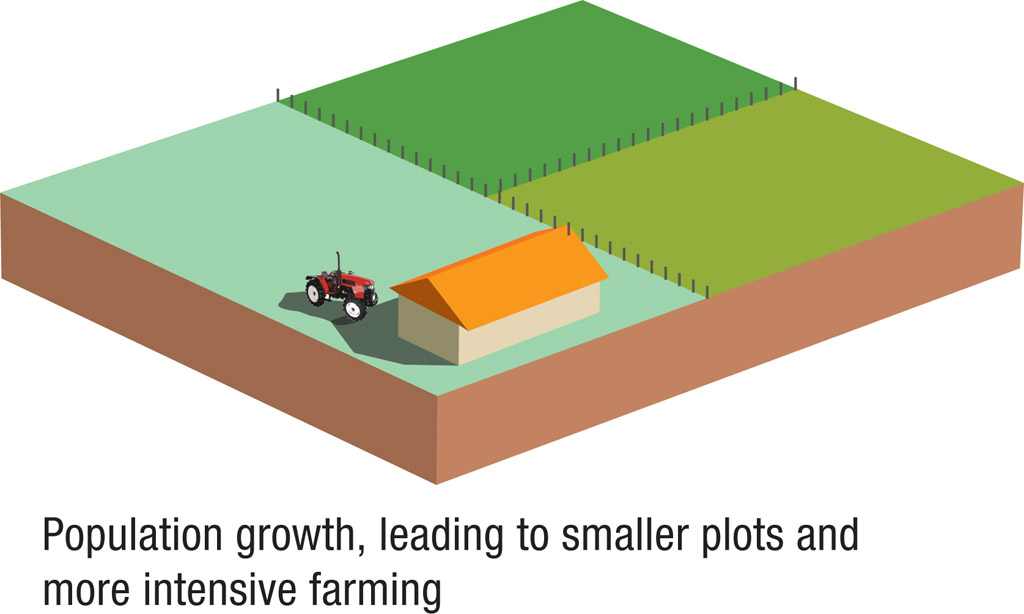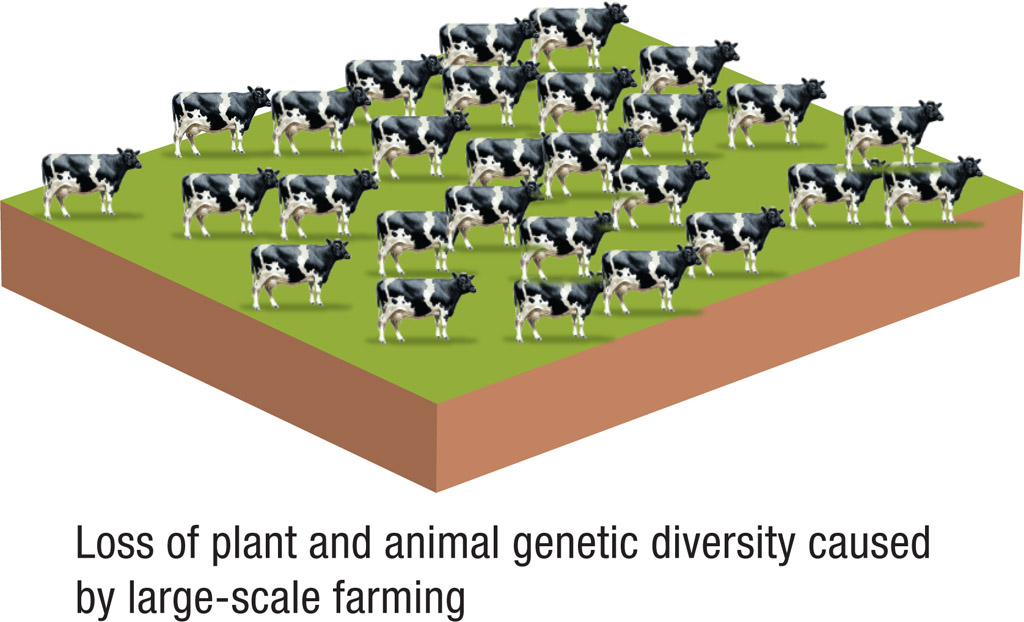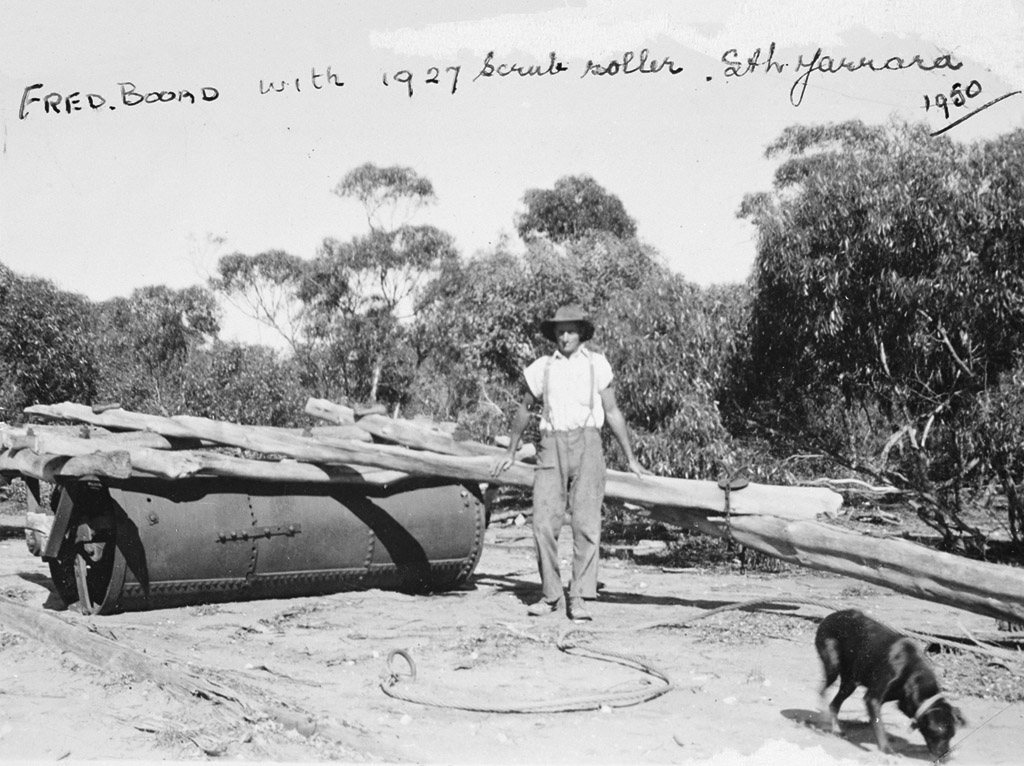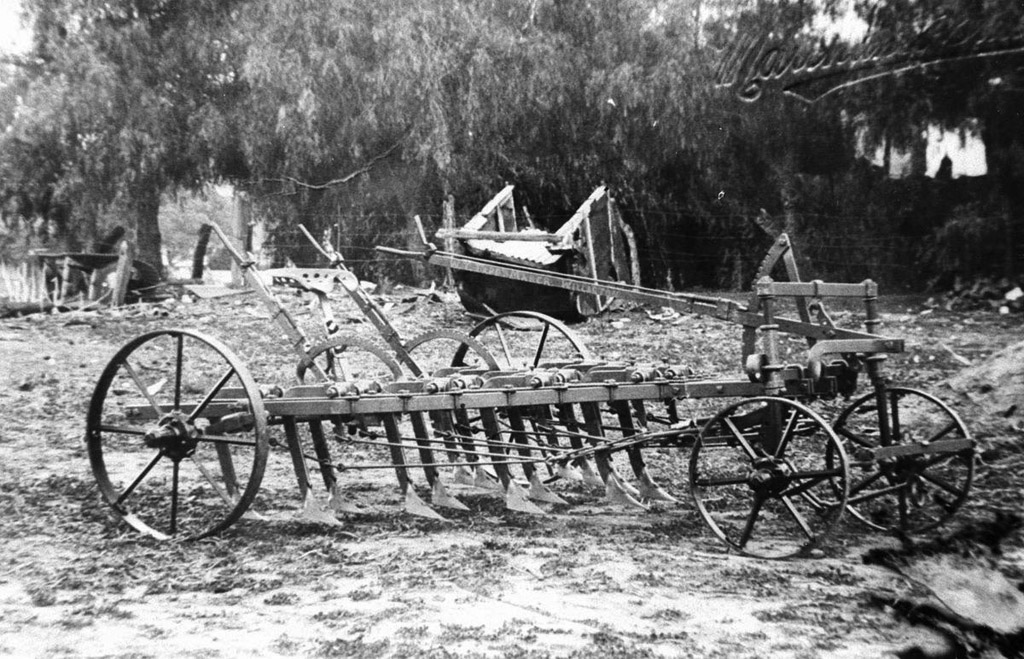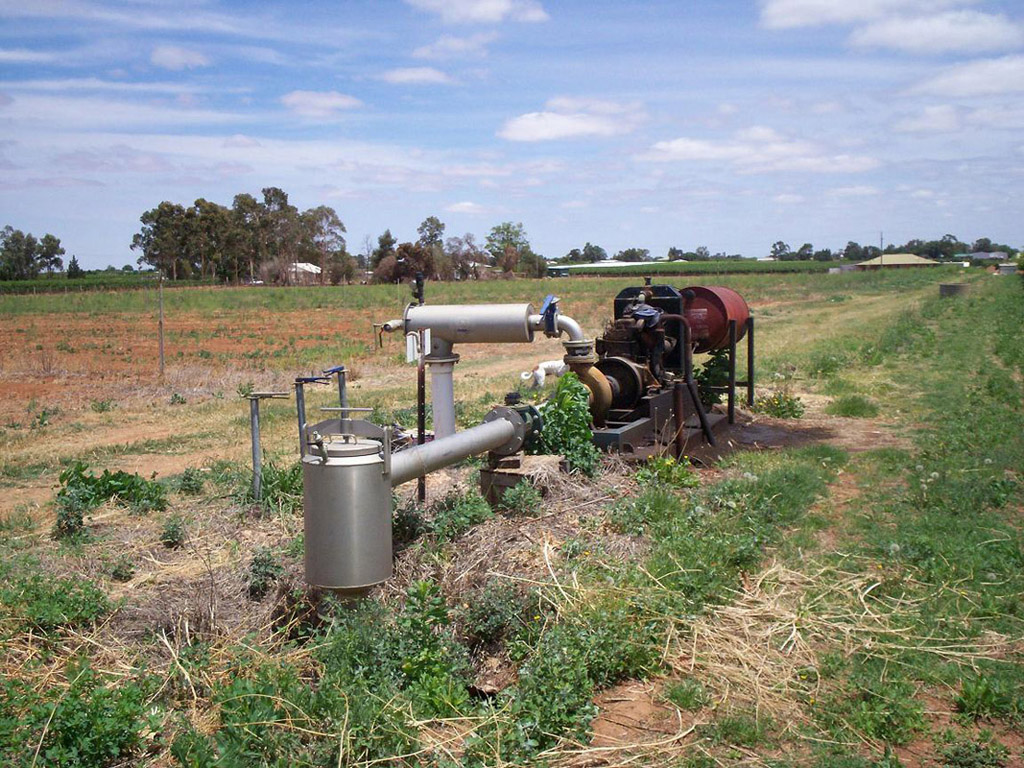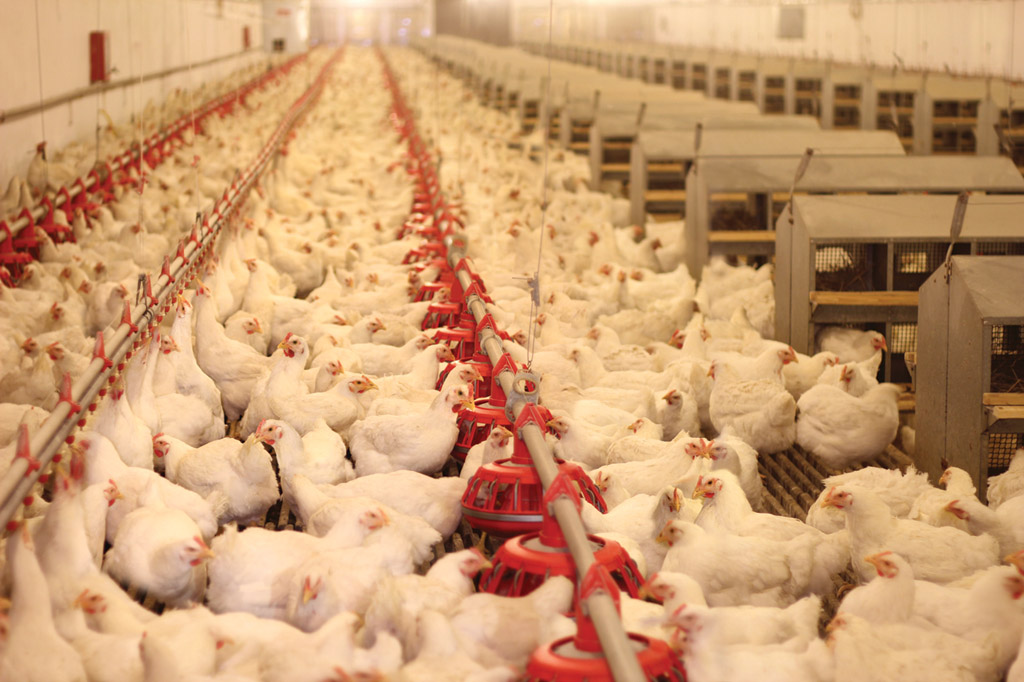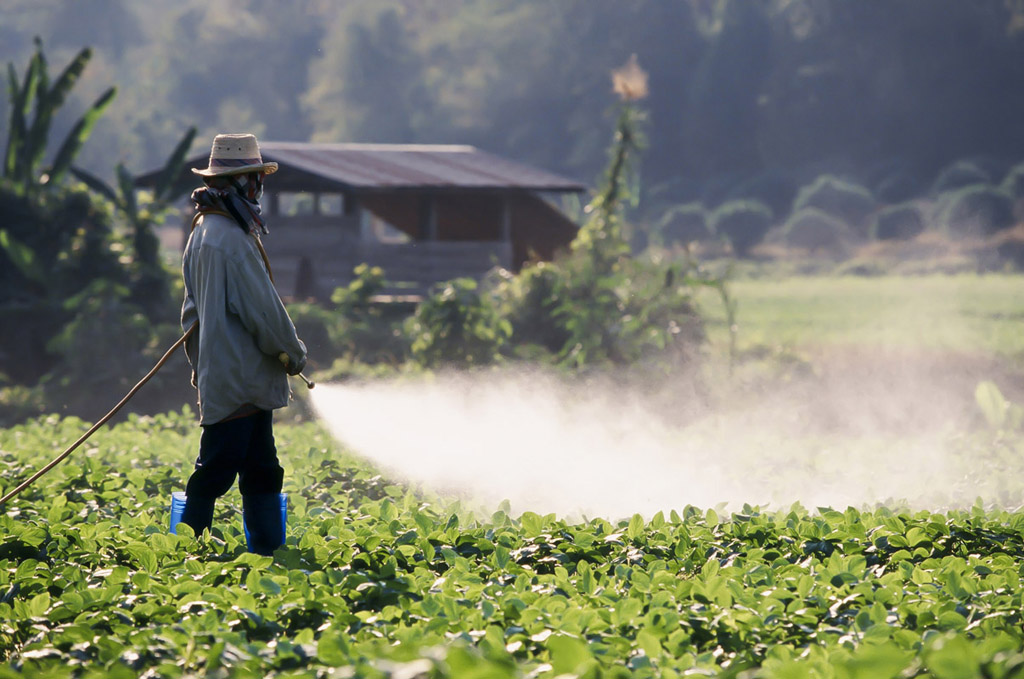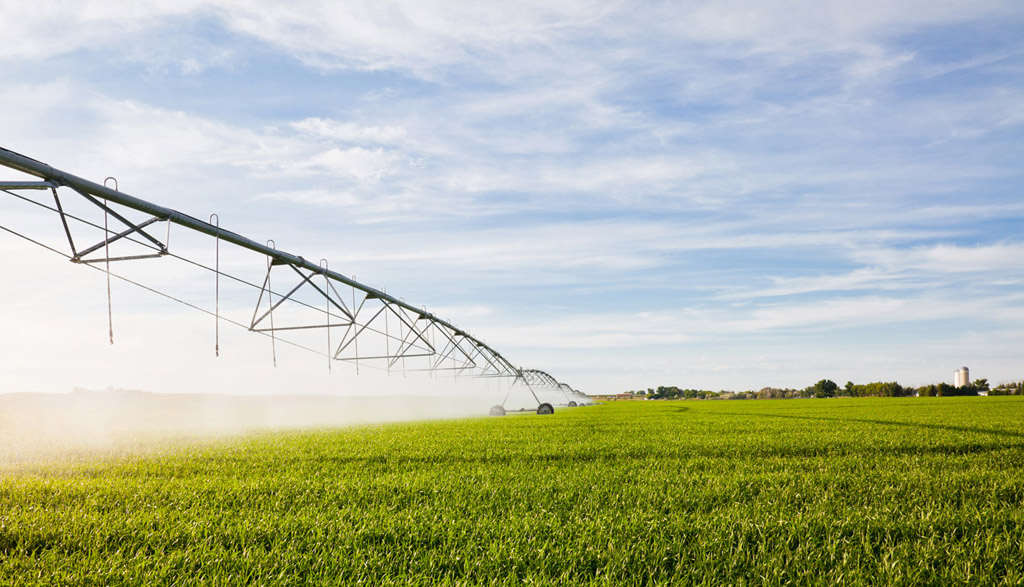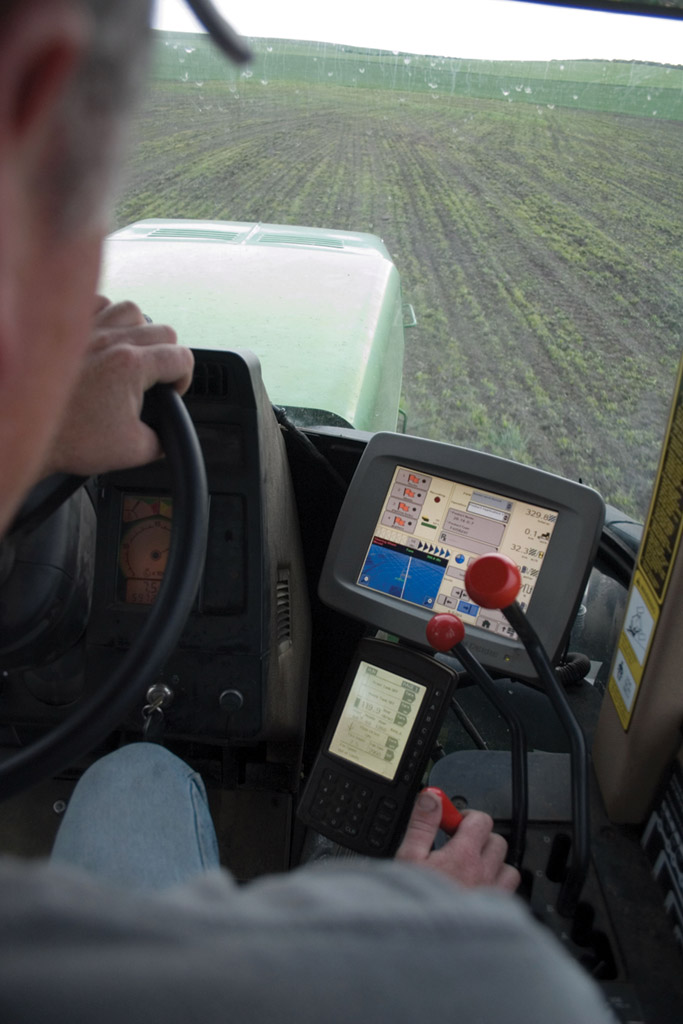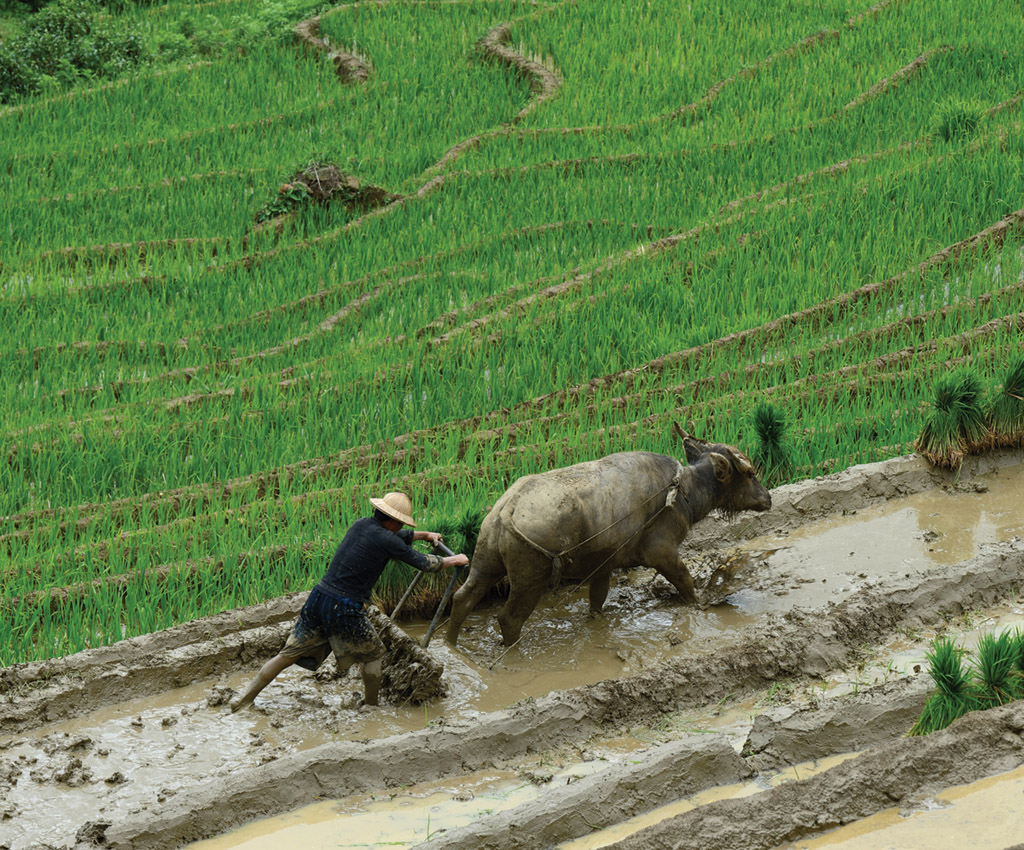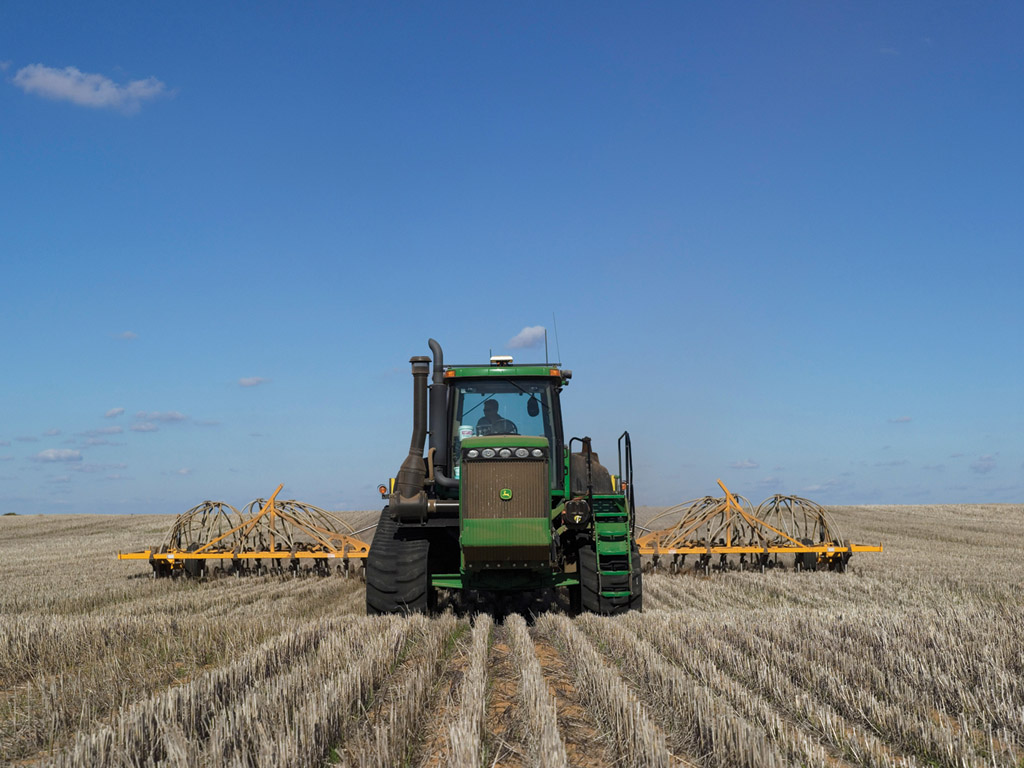4.2 Environmental impacts
Agricultural land use puts pressure on the environment. The results include erosion, salinity, loss of biodiversity and a decline in water quality. The term used to describe the impacts on natural systems that are additional to those which occur naturally is environmental degradation. Erosion, for instance, is a natural process, but agricultural practices which expose the soil to wind and rain, such as cattle grazing, are not – they are a result of human behaviour. Today, much is being done in Australia to try to address some of these issues, but some of the damage that has been created by past agricultural practices is substantial and costly to fix.
About two-thirds of Australia’s agricultural land is degraded to some degree, and in places the degradation is expected to continue because of the extent of the deterioration and the continued pressure of land use.
Much land degradation is directly linked to the replacement of native vegetation with introduced shallow-rooted pastures and cereal crops. Land degradation has also been a result of poor farming practices. The expansion of grain production throughout the nineteenth and early twentieth centuries in Australia left the land degraded. As each new wave of settlers occupied virgin land for wheat cropping, for instance, many of the farmers had little understanding of the need for crop rotation and resting of paddocks, so they would plant the same crop every year, until the soil was exhausted and fertility declined.
-
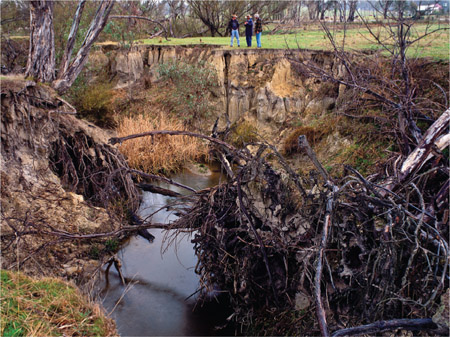
Source 4.16 Severe stream bank erosion along Castle Creek near Euroa, northeast Victoria -

Source 4.17 Sydney Harbour Bridge almost obscured by a severe dust storm in September 2009. The storm carried thousands of tonnes of precious topsoil into the atmosphere.
Soil erosion
Soil erosion is the result of wind and water removing soil from one place and depositing it in another.
While soil erosion is a natural process, disturbance of the land by various agricultural practices has increased the rate of erosion. On sloping lands that have been converted to cereal crops, the rate of erosion has increased by a factor of 50 in some instances. Agricultural practices which accelerate the process of soil erosion include land clearing, replacement of native grasses with introduced species, overgrazing and soil disturbance (through soil tillage such as ploughing or harrowing).
There are a number of ways in which erosion occurs. These vary according to the vegetation cover, the soil type and structure, the slope of the land and land disturbances or the activities of burrowing animals (such as rabbits and wombats).
In water erosion, the severity of the rainfall – severe rainfall is a large amount of rain falling in a short space of time – is a major factor in the degree of erosion and the amount of soil that is transported. In wind erosion the velocity of the wind is a major factor. The types of erosion that occur on agricultural land are:
- sheet erosion: when the topsoil is removed as a thin layer through the action of water flowing uniformly over an area of bare soil, such as land that has been cultivated for planting crops or has been overgrazed by livestock or pest animals such as rabbits
- rill erosion: where little rivulets of running water gather and cut small channels in the soil; also linked to farming practices such as cultivation or overgrazing
- gully erosion: when water follows drainage lines and washes away soil, cutting deep channels in the earth; under natural conditions vegetation moderates the effects of water flow by holding the soil together and protecting the ground from the direct impact of rainfall, but farming practices often remove much of the vegetation that slows down erosion
- stream bank erosion: stream banks erode as a natural process, but this process is accelerated by agricultural practices such as vegetation removal and damage caused by livestock going to the water to drink (Source 4.16)
- wind erosion: when land is left bare the soil is exposed to the actions of wind; when the wind reaches a particular velocity the process sorts the soil particles, removing the finer material containing the organic matter, clay and silt and leaving the coarser, less fertile material behind. The resulting dust storms can carry soil hundreds of kilometres, as the dust storms that engulfed Sydney in 2009 did, when soil from western New South Wales, an area which had been experiencing drought, was removed by strong westerly winds (Source 4.17).
Soil acidity
Soil acidity is a major problem for Australian agriculture. It is estimated that approximately 50 million hectares of surface soil and 23 million hectares of subsoil are affected in Australia’s agricultural zone. In 2001 the estimated annual value of lost agricultural production due to soil acidity was about $1.6 billion. Soil acidification, like erosion, is a natural process, but it is intensified by agricultural practices such as the use of nitrogen fertilisers and nitrogen-fixing pasture plants (such as clover or lucerne) – these change the chemical composition of the soil, leading to a decline in the ability of the soil to support enough vegetation to prevent soil erosion. These practices also limit crop and pasture growth because they affect the availability of nutrients that plants need, such as calcium, magnesium, boron and molybdenum.
Acidification can also lead to an increase in toxic levels of aluminium, iron or manganese.
Salinity
Salinity is another widespread problem which affects agricultural production in Australia.
Over 2.5 million hectares of agricultural land in Australia is affected by salinity; this is expected to grow to 12 million hectares in the next 50–100 years. This represents about 4.5% of currently cultivated land.
The presence of salt in agricultural land either kills the vegetation or causes a reduction in plant productivity.
Salt is a naturally occurring substance in Australian landscapes. Stores of salt are found in rocks and the soil, and much is locked away in underground water storages. These stores have been built up over millions of years from ocean salt spray, the weathering of rocks and the deposition of ancient ocean sediments when areas of the Australian landmass were below the sea. Low rainfall and the relative flatness of the Australian landscape have meant that this salt does not get flushed away through the river systems – it has accumulated in the water table.
Australia’s deep-rooted native plants, as they have adapted to the harsh Australian environment, have kept these underground salt stores in balance.
They have adapted so that they use all available water above the ground, intercepting much of the water before it enters the water table. This has kept the water table from increasing in size and rising – it needs to stay below the level of the root zone, because it can cause damage to the plants if it reaches the root zone.
With European settlement the water balance has changed. Land clearing for agriculture has replaced woodland and forest with shallow-rooted plants such as cereal crops and pasture grasses.
This has meant that less above-ground water is being taken up by plants, and so more water is getting through to the water table, raising it and bringing salt to the surface. Where this occurs in non-irrigated land it is known as dryland salinity.
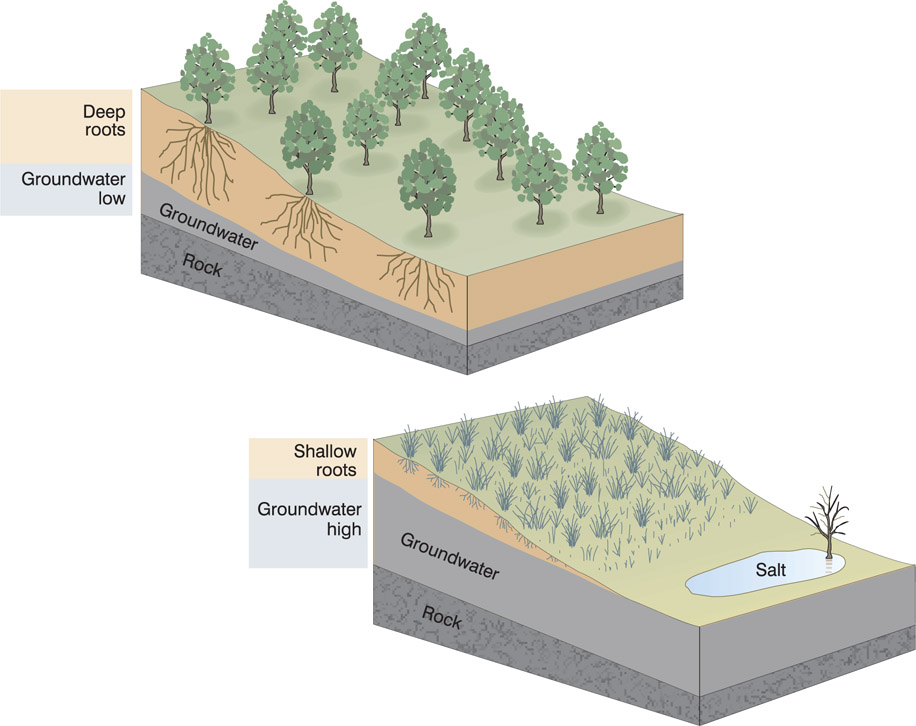
In irrigated areas, where excessive water usage is bringing the water table to the surface, it is known as irrigated salinity.
The signs of a salt-affected landscape are sick or dying trees, a decline in vegetation, colonisation by salt-tolerant weeds, salty bare patches on the earth and saline pools in creek beds. Water quality is affected as the salt is washed into rivers and streams; in extreme cases the water is made too salty for animals and humans to drink.
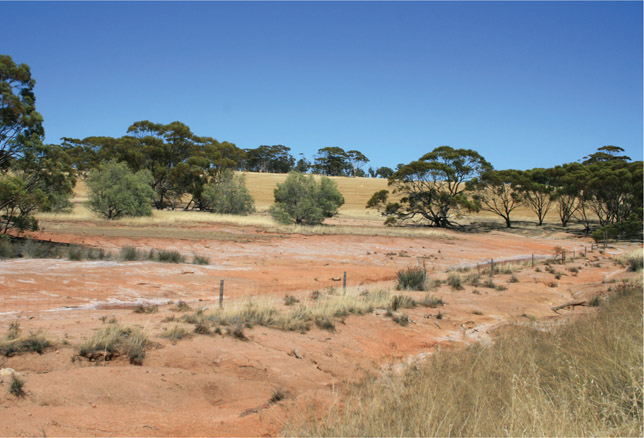
The loss of biodiversity in Australia is another factor affecting the productivity of agricultural land. Australian farmers have over generations contributed to biodiversity loss through soil disturbance, land clearing, the fragmentation of landscapes, monoculture farming practices, pesticide and herbicide use, the introduction of feral animals such as pigs and goats, the introduction of weed species and the depletion of water resources such as wetlands. Australian farmers have come to realise the importance of having a diversity of organisms (both plant and animal) to support agricultural ecosystems.
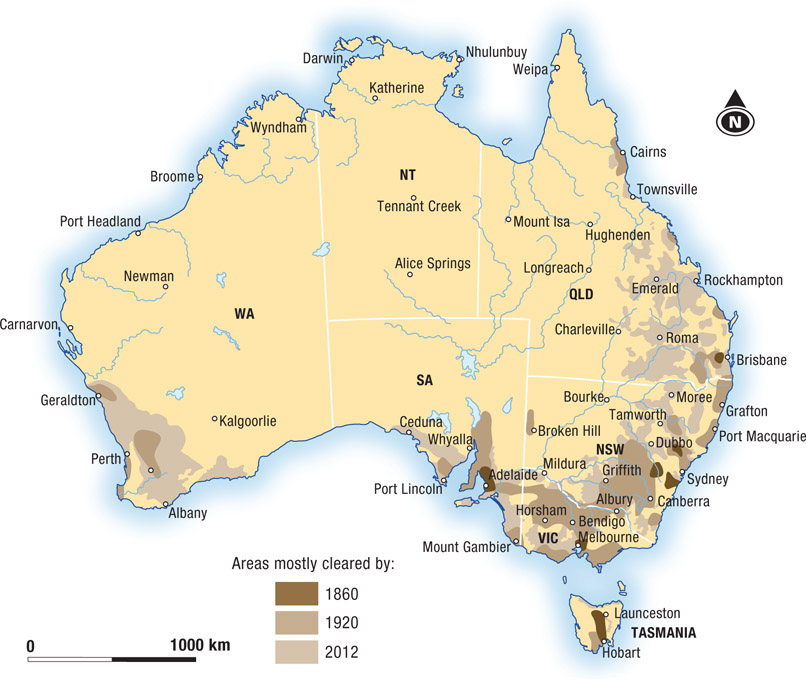
Healthy natural ecosystems have evolved to do what they do best:
- process and recycle nutrients and wastes
- provide insect pollinators for plants
- provide natural predators for pest species
- balance the water cycle and provide clean water
- stabilise the land and soil
- provide shelter and food for a multitude of organisms.
Without a healthy supporting ecosystem, agricultural systems become vulnerable to pressures we have discussed, such as soil erosion, salinity, and pest and disease invasion.
In the past a lack of understanding about how healthy natural ecosystems help keep environmental systems in balance led to the increasing reliance by farmers on synthetic pesticides for pest control.
The unfortunate side-effect of this reliance is what is known as the pesticide treadmill. This is where insect pests develop immunity to the pesticide and the farmer is forced to use greater concentrations or more powerful variants of it, and this continues in a cycle as the pests develop greater tolerance to the new regime.
It is a cycle which increases the likelihood of soil and water contamination over time.
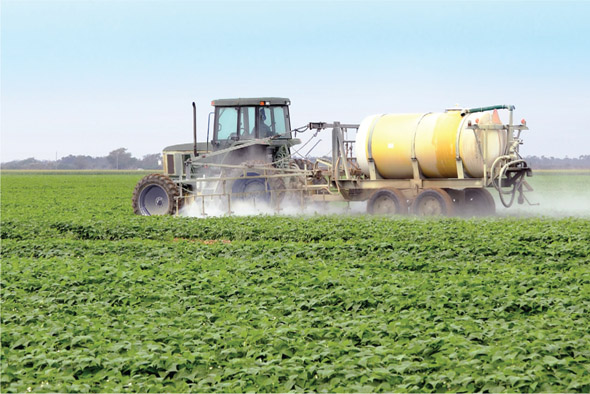
Water quality decline
The decline in water quality as a consequence of agricultural practices and environmental degradation is a major issue in Australia. One of its most immediate impacts is a decline in the quality of water used for human and livestock consumption. Intensive land use along the Murray River is creating significant issues for the people of Adelaide in South Australia, who rely on water from the Murray River for personal consumption.
The increasing salinity of the river system is not only making the water unpleasant for drinking but it also speeds up the deterioration of infrastructure such as water pipes.
Other things that lead to a decline in water quality include increased sediment flows into rivers and streams as a result of erosion, and fertilisers, herbicides and pesticides flowing into waterways from agricultural runoff.
Two of the main fertilisers that are entering Australian waterways as runoff are nitrogen and phosphorus. Australia’s ancient soils are naturally deficient in these two elements and the discovery in the early twentieth century that the addition of phosphorus and nitrogen to pastures and crops could significantly boost agricultural production was seen as a revolution in farming in Australia.
It was later discovered, however, that the entry of these fertilisers into Australian waterways through runoff from farms was having major environmental consequences.
One of these is algal blooms (growth) in rivers and lakes. Algae are naturally occurring microscopic organisms, and in low numbers they are important contributors to the ecology of water bodies. Increased nutrient loads from farm fertilisers, however, are causing these organisms to multiply to levels, in some species, at which they can produce toxins that are fatal to humans and animals. Unchecked algae growth also reduces oxygen levels, causing widespread fish deaths.
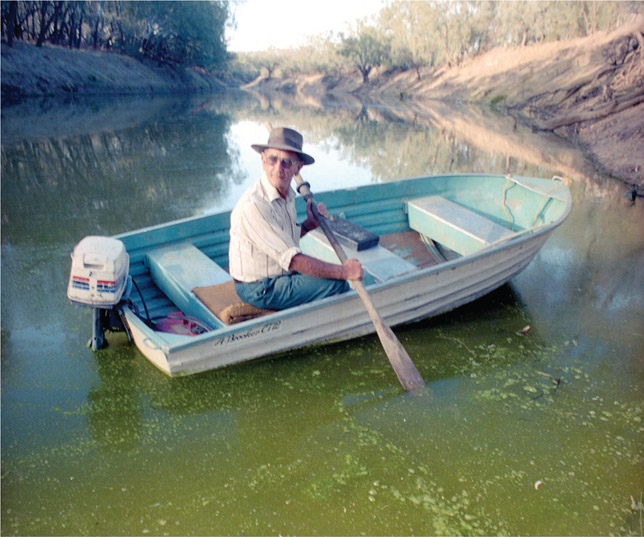
Other consequences include increased turbidity and unsightly scums which affect the smell and taste of the water.
Increased research into land and plant science is now helping farmers deal with excess fertiliser loads. Farmers now use a balance sheet approach to fertiliser applications, and apply them much more effectively. They have a greater understanding of nutrient inputs (fertilisers, soil conditioners and legume nitrogen fixation) and nutrient exports (such as how much fertiliser is harvested with the crops, and losses to groundwater, rivers and atmosphere), so they can develop an appropriate management plan. This is much more environmentally effective, ensures optimal productivity and saves the farmer money.
DEVELOPING YOUR UNDERSTANDING 4.7
- Describe how the widespread removal of native vegetation for agricultural production has contributed to dryland salinity.
- Explain how increased acidity of the soil inhibits agricultural production.
- List the positive and negative impacts of the use of fertilisers in Australian agriculture.
- Summarise the pesticide treadmill.
- Discuss how the ‘balance sheet’ for fertiliser application works and the benefits of this strategy to the farmer and the environment.
- In the left-hand column of the table below are a number of activities that farmers could use to address environmental issues on their farms. Match these with the reasons why these activities might be carried out.

Strategy Reason Plant native trees in paddocks. Encourage biodiversity. Build fences around areas of salinity and along creeks and rivers. Promote a natural filter to intercept sediment and fertiliser run-off. Use a balance sheet approach to fertiliser application. Reduce the level of the water table. Restore wetland areas. Prevent livestock trampling the land, thus reducing erosion and stabilising the soil. Match animal numbers to the availability of feed. Reduce the amount of pesticide needed. Set aside areas of land for nature reserves. Minimise the amount of fertiliser entering waterways. Encourage natural insect predators. Avoid overworking the land. - Explain how the practices of the selectors and the soldier settlers, as they tried to make unproductive land sustain a living, had a greater negative impact on the environment than the vast sheep and cattle runs of the squatters.
- Suggest how issues of environmental degradation might affect future agricultural production in Australia.
Agricultural innovation and agricultural productivity in Australia
Australian farmers have been very successful at finding innovative solutions to problems and maximising agricultural productivity. The early development of agriculture was derivative – the crops, livestock, technology and concepts of agricultural production were all imported from overseas – so a lengthy process of adaptation and innovation had to take place before successful systems of Australian agriculture evolved.
Australia has a rich history of agricultural inventions and technological adaptations to suit Australian conditions and increase productivity.
Some of the more notable ones came around the end of the nineteenth century:
- The stump jump plough allowed a farmer to plough areas from which stumps and roots had not been fully cleared. This invention was especially important in the opening up of the mallee country in Victoria and South Australia.
- The combine harvester stripped, threshed and winnowed wheat. This invention, which was pioneered by H. V. McKay, an agricultural engineer from Victoria, allowed farmers to harvest wheat crops on a large scale.
- The scrub roller, which is dragged through the bush to flatten the vegetation, opened up vast tracts of light bush country.
- Large-scale irrigation, developed by the Chaffey brothers around Mildura, allowed intensive agriculture to be expanded into Australia’s dryland agricultural zone.
- William Farrer, in the late 1800s, bred a number of new wheat varieties, the most notable of which was an early-maturing wheat strain named ‘Federation’, which was drought and disease resistant.
The Green Revolution
However, it was during the twentieth century that the most widespread impacts of agricultural innovation and adaptation occurred. Across the world this period became known as the Green Revolution, and it was driven by advances in agricultural science and technology leading to a greater understanding of efficient land, soil and water management practices. Coupled with this were advances in the understanding of plant and animal genetics and dramatic improvements in the science of animal husbandry.
The technological advances in agricultural science were driving dramatic productivity improvements, and these were being supported by other factors, such as:
- mechanisation and the development of specialised agricultural machinery
- technological advances such as the use of computers and the internet
- the development of pesticides, herbicides and fertilisers and their increased use
- the development of specialised agricultural production enterprises such as factory farms for production of livestock such as pork and poultry
- the development of intensive agriculture infrastructure such as greenhouses for fruit and vegetables
- the involvement of big business in agricultural enterprises
- the development of multinational companies that support agricultural production, such as the global agricultural giant Monsanto, which has invested hundreds of millions of dollars into seed and agricultural chemical research and development
- government investment in agricultural infrastructure such as irrigation schemes and railway and other transport networks
- government policies that favour maximising production, such as diesel fuel rebates for farmers, reducing the cost of fuel.
DEVELOPING YOUR UNDERSTANDING 4.8
Wheat production in Australia
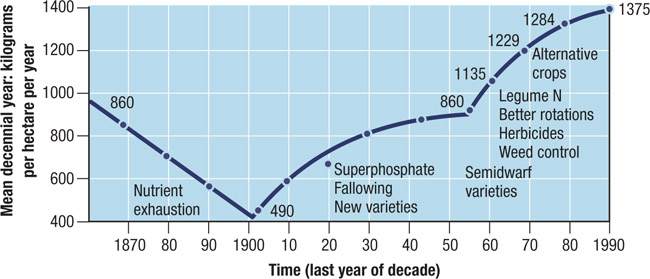
One of the outcomes of the Green Revolution was the development of higher-yielding strains of cereal crops; these have allowed increased food production to meet the demands of an increased population. One measure of these improvements is wheat crop yields.
By the end of the nineteenth century inefficient agricultural practices such as continuous planting of crops on the same land were having a clear effect on crop yields in Australia: they were declining significantly because of a reduction in soil fertility.
By the end of the twentieth century crop yields had almost quadrupled. In the case of wheat, the introduction of practices which increased nitrogen levels in the soil, and the use of superphosphate from the 1950s onwards, resulted in substantial improvements in crop yields through improved soil fertility. A better understanding of land management resulted in the widespread adoption of the ley (or rotational) farming system in dryland agricultural areas. This system involves resting and rejuvenating land through cycles of crop planting alternated with turning the land out to pasture.
When the land is under pasture, farmers can graze sheep or cattle and maintain the profitability of the land. This system replaced earlier farming techniques where crops were planted year after year until the soil was exhausted. The rotation of crops with pasture grasses or legumes helps improve soil stability, increases the amount of organic matter in the soil, fixes nitrogen into the soil and improves weed and pest control.
Continued research throughout the twentieth century further assisted wheat production with the breeding of higher-yielding disease-resistant wheat strains, the development of chemicals to control pests and weeds, and greater understanding of the role of trace elements in plant growth. The wheat industry was also improved by increased mechanisation and technological progress.
The introduction of tractors in the 1940s greatly assisted production, as did the development of the self-propelled combine harvester, which didn’t require horses to pull it. These harvesters became widespread across the Australian wheat belt after the 1950s.
Just as society moved into the digital age, so did farming. Farmers now use GPS to map out the planting of crops, so they can minimise soil compaction by tractors travelling over the same ground again and again, and there are sophisticated computer software programs that allow them to measure crop yields based on nutrient balances in the soil.

| Benefits of conventional tillage | Benefits of no-till method |
|---|---|
|
|
| Disadvantages of conventional tillage | Disadvantages of no-till method |
|
|
Source 4.28a Rick Llewellyn of the CSIRO talks about no-till farming in South Australia. (04:05)


